What can men do against such reckless beauty, such wanton loveliness? How can a game so obviously gorgeous, so well-constructed, still tilt uneasily forward and stumble? And if a game reaches so hungrily for greatness that it trips over itself, is it enough that it reached at all?
Child of Light, out this week for home consoles and PC, comes to us from director Patrick Plourde and writer Jeffrey Yohalem, the duo behind Ubisoft’s blockbuster 2012 action game Far Cry 3. Child of Light is about as far from Far Cry 3 as one could reasonably get, and in fact often feels like a self-conscious overcorrection. “Wait,” its creators seem to have said. “We don’t just want to tell stories about college bros blowing up jungles with bazookas. We want to tell coming-of-age fairy tales about little girls, too!” As stylistic pendulum-swings go, it’s a neck-straining one.
Child of Light tells the story of Aurora, the daughter of a duke in late-19th-century Austria. As the game’s lovely animated prologue informs us, Aurora’s mother wasn’t really in the picture, so her father grew lonely and fell in love with another woman. A stepmother, one could call her, and if you think you know where this is going, I have good news for you: You do.
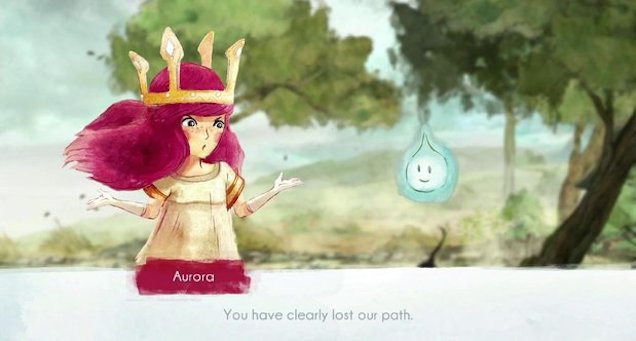
One night Aurora takes ill and by all appearances, dies in her sleep. Of course, she isn’t really dead; she awakens instead in the magical land of Lemuria. The game’s story charts Aurora’s adventure through Lemuria as she uncovers the Dark Queen Umbra’s plot to usurp the kingdom’s rightful rulers and claim power for herself.
As Aurora sets out to defeat Queen Umbra and heal the kingdom, she befriends a number of charming Lemurians — A mouse archer! A bearded wizard! A pair of tumbling acrobats! — each of whom lends his or her complementary fighting abilities to the cause. With the help of her friends, young Aurora eventually learns to leave childish things behind and embrace her destiny as a great leader.
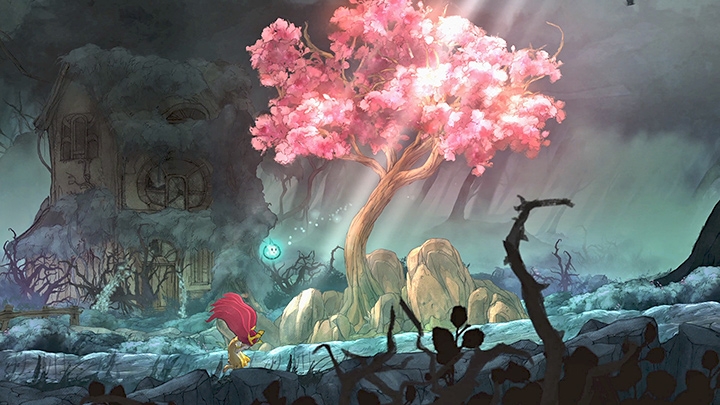
I didn’t go into Child of Light expecting the story to hit me on the same level as similar fairy tales like, say, Philip Pullman’s His Dark Materials or C.S. Lewis’ The Chronicles of Narnia, but I also wasn’t expecting the story to leave me feeling quite as disappointed as it did. Visually, Child of Light is flat-out gorgeous. But that surface-level beauty can only carry a game like this a certain distance, and Child of Light‘s story mostly fails to carry it the rest of the way. The whole thing is just so pat and straightforward — the villains are villainous, the heroes are heroic, and as the credits rolled, I found myself saying, “Well, that went pretty much how I was expecting it to.”
It’s sweet without the complementary tartness of the best fables, and hopeful without the bittersweet sadness of the best coming-of-age stories. There’s no great moment of loss or learning, no funny darkness or shocking turn. It’s all kind of just there, which feels strange to say of a game that so clearly wants to do more than just show up.
As I played, I kept having the same two thoughts: 1) They are trying so hard to make a beautiful/meaningful/profound game and 2) Am I a huge jerk for being unmoved by it?
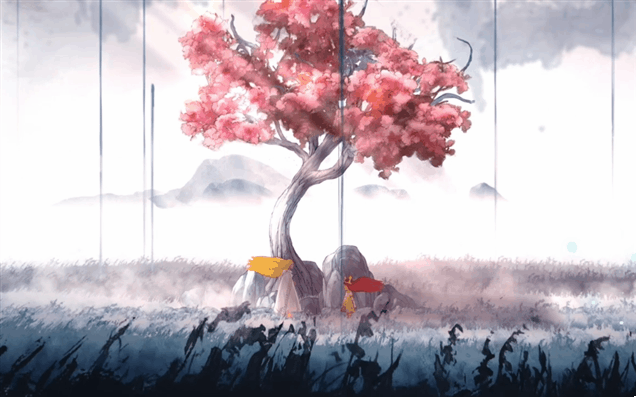
Take, for example, the fact that every line of dialogue in the game rhymes. What an admirable feat for a writer to even attempt! And yet more often than not the end result is distracting and faintly indecipherable. I would be affected by the undeniably beautiful visuals — two characters standing below a lone pink tree, droplets of colour pulling the landscape upward like a painting dipped into water — only to find myself raising an eyebrow at what these people were actually saying to one another, at the clumsy synonyms of an enforced rhyme scheme.
Fortunately, story gripes aside, Child of Light is a lot of fun to play. Exploration is, for the most part, a simple matter of navigating two-dimensional environments and occasionally avoiding traps while solving simple “push the crate forward until it lands on a button”-type puzzles. But the primary appeal of Child of Light lies in its terrific turn-based combat system.
Each time Aurora bumps into a patrolling enemy, the game warps into a battle sequence in which she and one other party member square off against one to three opponents. The battle system will feel familiar to anyone who has played a Japanese role-playing game — players trade turns with the enemy and can combine spells and physical attacks to whittle down their opponents’ health bars. Some enemies are vulnerable to fire, others to electricity, others to water. If your health gets low, you drink a health potion. If you’re in over your head, you flee. You get the idea.
That’s all pretty straightforward, but the brilliance of Child of Light‘s combat — and it is brilliant — lies in the bar at the bottom of the screen.
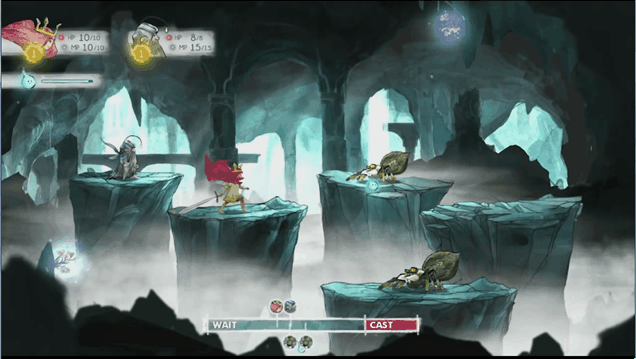
The bar represents the passage of time, and each character is constantly moving along it from left to right. As your characters hit the white marker near the right-hand side, time freezes and you’re allowed to choose their actions for this turn. After selecting an action, the character must then make it uninterrupted through the red “CAST” area to the far-right end of the bar, where they will complete the action.
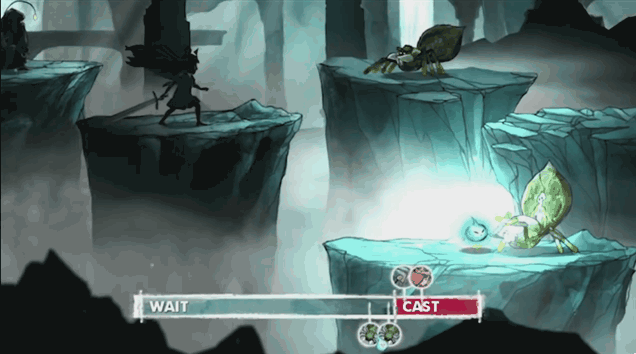
If you’re able to score a hit on an enemy while it’s within the red zone, you’ll perform an “interrupt” and cancel its action, setting it back a ways on the timeline. (The same thing’ll happen to you, should an enemy hit you while in the red.) Interrupts are everything in Child of Light, and combat quickly becomes a race through the red, with you hoping that your character beats out the enemy and interrupts his move, rather than the other way around.
To do that successfully you’ll have to choose your actions carefully — some moves are very fast, while other more powerful moves take much longer and can leave you exposed for a good few seconds. With a mix of quick reactions and careful strategy, it becomes possible to run the table on your enemies, interrupting them every time they try to attempt to attack and bringing them down without allowing a single move in response.
On top of all that, you’re also able to quickly swap characters in the middle of a fight without any penalty. This leads to a surfeit of options for any given combat scenario. For example, if your wizard Finn arrives at his turn and sees an enemy ahead of him halfway through the red zone, you can choose to have him enact a quick, weak melee attack in the hopes that he’ll beat them to the endpoint, thereby interrupting their move. Or, you can have him take a defensive stance, which will reduce any damage he may receive and make him move along the timeline faster on his next turn. Or, you can swap in Rubella the jester, who has a speedy melee attack that can beat out any but the fastest enemies… or, or, or…
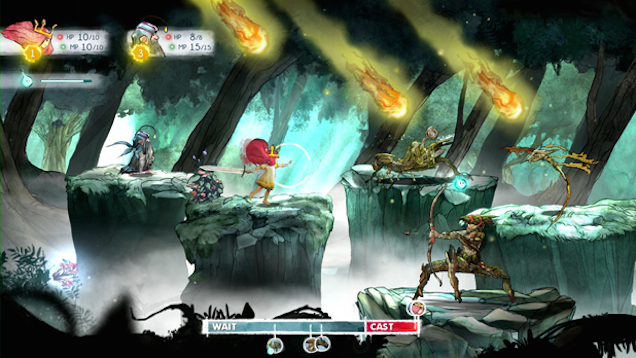
Actually, there is one more big “or” that’s worth mentioning — you can command Aurora’s free-roaming companion Igniculus to flash light on an enemy, blinding it and greatly slowing its progress down the timeline. By carefully flitting Igniculus from enemy to enemy, savvy players can manipulate their foes into hitting the red zone just a little too late every time, thereby making it even easier to repeatedly interrupt their attacks and deny them the chance to inflict damage.
Controlling Igniculus gives the turn-based battles a real-time twist, and it can all seem like a lot to keep straight at first. But once I got into a groove and was regularly tricking enemies into being vulnerable to interruption, combat became incredibly satisfying.
Child of Light is also a terrific co-op game. At any time, a second player can pick up the controller and take over control of Igniculus, which greatly changes the dynamic of the game. I played a large percentage of Child of Light in tandem with my girlfriend, and we had a blast with combat, carefully planning, strategising, and debating whether or not to gamble on close-call interrupts.
“He’s halfway through the red, but he’s not moving that fast,” she’d say. “I think I can go for it,” I’d reply. I’d select my action, she’d begin to shine her light, the game would kick into action… we’re catching up…she’s blinding the guy…we just got past him…. YEAH, interrupt! Many high-fives were exchanged.
What’s most impressive about Child of Light‘s combat system is how economical it is, and how well everything holds together. That the game allows players to swap through their entire party mid-battle with no penalty — something it shares with only a few other turn-based RPGs like the terrific Final Fantasy X — speaks to how much care has gone into keeping combat balanced, tight, and flexible. Time and speed become paramount — rarely has a “haste” spell felt this crucial! — and every attempted interrupt is a small but energizing gamble.
There are, of course, things about Child of Light‘s combat system that don’t quite work — in particular the “oculi” crafting system, in which you combine and equip gems to bolster your characters’ stats. The oculi system is cool in theory but clunky in practice, mainly because equipped oculi vanish from your main inventory and make it impossible to tell just how many of the crystals you have at a given time. You can’t examine a character’s equipped items or equip new crystals while in battle, making it difficult to remember just who has that water-enhanced weapon you need. And the limit of two on-screen characters at a time often feels restrictive, rendering spells like “heal all” and “cure all” much less useful than they are in other turn-based RPGs. Particularly during boss battles, it’s hard not to imagine how much more fun this game could’ve been had players been given a three-character party.
But those gripes are comparatively minor when placed up against what Child of Light does well. It is an elegantly designed and tightly constructed game, an array of simple parts that interlock to form a complex yet easily graspable whole. When I finished the game on normal difficulty, I realised that I had never once “lost” a battle or seen a game-over screen. Despite that, my primary memory of Child of Light is that of being consistently challenged, and rarely feeling overpowered or over-equipped. I’m enamoured of any game that is well-designed enough to feel challenging even if it is in truth easier than it lets on. (And of course, it offers a stiffer challenge on its harder difficulty setting.)
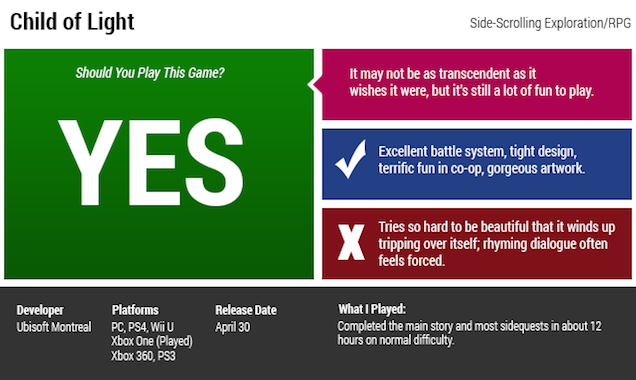
So, Child of Light: Beautiful art and a terrific battle system hampered by a ho-hum story with an overly ambitious rhyme scheme. Yet that assessment feels reductive. At its best, Child of Light is great, gorgeous fun, and at its worst it is merely uninspired. Even then, it remains unusual in so many welcome ways that I can’t help but recommend it.
Here we have the rare game that not only stars a young woman (amid a predominantly female cast!) but challenges her without condescending to her or disempowering her. The magical kingdom may be narratively unremarkable, but it is rendered so sumptuously as to induce shivers. The morals of the story may be trite — trust your friends, don’t be a jerk, never underestimate redheads — but they are fundamentally worthy. And while we may know that the good guys will win, their battles remain thrilling nonetheless.
Whatever complaints I have about Child of Light‘s execution cannot overcome how glad I am that a game like this exists at all. Child of Light may try too hard to be good and pure, and it may reach too greedily toward transcendence. But at least it’s trying; at least it’s reaching.
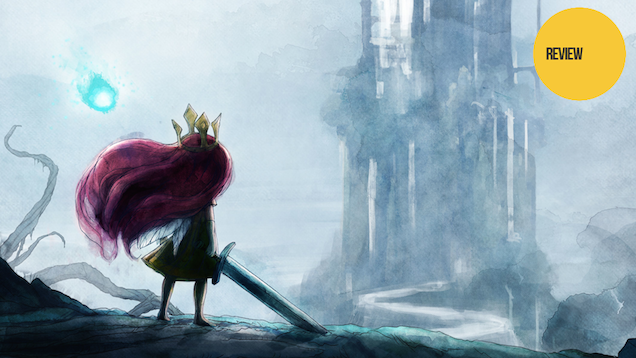
Comments
14 responses to “Child Of Light: The Kotaku Review”
I’m really glad that this game has terrific co-op. I was really hoping to play this one with my girlfriend. Judging by the trailers and gameplay footage, I was afraid that my role (being the second player) would be simply click on certain objects to interact them, whilst the bulk of gameplay and combat is done by the first player.
I’m a bit confused though, would I be able to control a secondary character in combat? Or is it simply a supporting role?
Absolutely he plays a role in combat! In combat, the little spark can be used to confuse enemies and do a few other moves. One example, is how you can make him glow really bright, doing this can make an enemies ‘charge time’ significantly lower, making you overshoot them dramatically in charging time for attacks, allowing you to essentially beat the crap out of them 🙂
Here we have the rare game that not only stars a young woman (amid a predominantly female cast!) but challenges her without condescending to her or disempowering her.
Why do I get the feeling that this is going to cause a shitstorm of controversy?
Because any comment relating to women is offensive and controversial.
3.. 2.. 1..
Because it’s written in a superior tone with an amount of hyperbole designed to provoke a reaction instead of simply stating a fact and complimenting the game for it? It would have been sufficient to say “Child of Light stars a young lady who overcomes the challenges placed before her with a sense of self-reliance and independence.” Explicitly calling out that a female lead is “rare” and that there is a predominantly female cast is just flame baiting.
It would be nice if we could move to a point where a female lead doesn’t need to be brought up but we still live in a childish world in which boys are close to rioting for their female characters to have large tits and stripper heels.
Of course we can also point out that ironically by mentioning that it doesn’t ‘disempower of condescend her’ we end up doing exactly that rather than just looking at it and going ‘Oh cool, it’s a good game, female character, cool graphics, great gameplay…’
I had a run of the demo and it didn’t grab me. A shame. This should be a game I like!
I’m enjoying it….as is my nearly 3 year old daughter. I only downed two bosses before bed, but the combat is nice and the artwork exceptional. The music design is superb as well, so I recommend cranking this through your hi-fi.
While I haven’t had a chance to play the game, it’s good to see a review be slightly critical of some of the ‘artsy’ elements of a game when they don’t quite work.
I think sometimes game reviews are so obsessed with seeing games portrayed as legitimate, varied forms of art that they go a bit overboard with praise as soon as a game is artsy or different.
I’m not saying there isn’t merit in making games which have interesting art styles or themes which appeal outside the ‘dudebro’ market, just that it’s refreshing to see a reviewer objectively analysis those design choices rather than just going “IT’S WATER PAINTED ART! 10/10”.
The battle system is straight out of Grandia. And it still is probably the best JRPG battle system out there. Which begs the question: why has no one stolen it until now?
And now I’ve been convinced to try Grandia lol
Grandia II is the best of the series IMO. It’s dated quite badly (especially the dub which was pretty awful) but despite being very linear it’s one I would dig my Dreamcast out every few years to re-play because of how fun the combat is. If my DC was still alive I’d probably do it again, overdue for another replay.
At the moment I’m about halfway through the game.
I have to disagree on the rhyme. It seems a lot of reviews dislike the rhyming scheme, or grow bored of it, I utterly disagree. It’s meant to be fun and whimsical, and there’s a cheekiness in some of the script, as in it’s meant to be poetic and beautiful, but it also doesn’t take it self too seriously (the character who cannot rhyme, for example).
The combat system is excellent. The crafting/gearing system is simplistic yet enjoyable, allowing for decent customization without getting too bogged down.
I’m thoroughly enjoying it, script included. It’s a shame most professional game reviewers, in my opinion, lack the appreciation of the whimsy the rhyming scheme introduces, a cheeky, yet not immature, playfulness, more games to could do with.